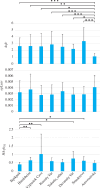Was the steppe bison a grazing beast in Pleistocene landscapes?
- PMID: 39144492
- PMCID: PMC11321853
- DOI: 10.1098/rsos.240317
Was the steppe bison a grazing beast in Pleistocene landscapes?
Abstract
The history and palaeoecology of the steppe bison (Bison priscus) remain incompletely understood despite its widespread distribution. Using dental microwear textural analysis (DMTA) and vegetation modelling, we reconstructed the diet and assessed the habitat of steppe bison inhabiting Eurasia and Alaska since the Middle Pleistocene. During the Late Pleistocene, steppe bison occupied a variety of biome types: from the mosaic of temperate summergreen forest and steppe/temperate grassland (Serbia) to the tundra biomes (Siberia and Alaska). Despite the differences in the identified biome types, the diet of steppe bison did not differ significantly among populations in Eurasia. DMTA classified it as a mixed forager in all populations studied. The DMTA of Bb1 bison-a recently identified genetically extinct sister-clade of Bison bonasus-was typical of a highly grazing bovid species and differed from all B. priscus populations. The results of the study temper the common perception that steppe bison were grazers in steppe habitats. The dietary plasticity of the steppe bison was lower when compared with modern European bison and may have played an important role in its extinction, even in the stable tundra biome of eastern Siberia, where it has survived the longest in all of Eurasia.
Keywords: Bb1 bison; Bison priscus; dental microwear textures; diet; habitat use; vegetation modelling.
© 2024 The Author(s).
Conflict of interest statement
We declare we have no competing interests.
Figures




References
-
- Mondanaro A, et al. . 2021. The role of habitat fragmentation in pleistocene megafauna extinction in Eurasia. Ecography 44 , 1619–1630. (10.1111/ecog.05939) - DOI
-
- Boeskorov GG, Potapova OR, Mashchenko EN, Protopopov AV, Kuznetsova TV, Agenbroad L, Tikhonov AN. 2014. Preliminary analyses of the frozen mummies of mammoth (Mammuthus primigenius), bison (Bison priscus) and horse (Equus sp.) from the Yana-Indigirka lowland, Yakutia, Russia. Integr. Zool. 9 , 471–480. (10.1111/1749-4877.12079) - DOI - PubMed
-
- Boeskorov GG, et al. . 2016. The yukagir bison: the exterior morphology of a complete frozen mummy of the extinct steppe bison, Bison priscus from the early holocene of Northern Yakutia, Russia. Quat. Int. 406 , 94–110. (10.1016/j.quaint.2015.11.084) - DOI
-
- Zazula GD, Hall E, Hare PG, Thomas C, Mathewes R, La Farge C, Martel AL, Heintzman PD, Shapiro B. 2017. A middle holocene steppe bison and paleoenvironments from the Versleuce Meadows, Whitehorse, Yukon, Canada. Can. J. Earth Sci. 54 , 1138–1152. (10.1139/cjes-2017-0100) - DOI
Associated data
LinkOut - more resources
Full Text Sources
Miscellaneous

